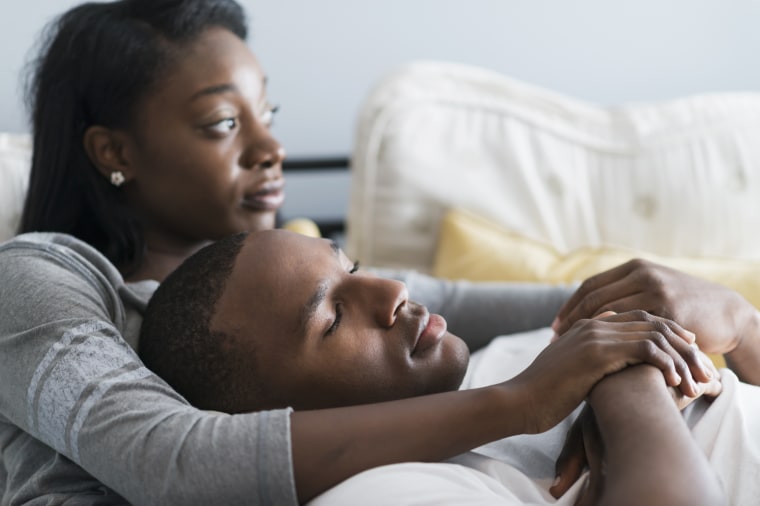Are you and your partner always at odds? Negativity bias may be to blame, according to California-based marriage therapist Lisa Brookes Kift.
A “negativity bias” refers to the neuroscience of feeling threatened by your partner even when there isn’t a reason to be, according to the therapist.
“When couples get in a pattern of behaving over long enough, they start to create their own negativity bias within the dynamic where they both are assuming that the other is going to respond in a certain way and it’s negative,” Kift tells NBC News BETTER.
The pattern becomes automatic: One partner anticipates the other will behave a certain way and gets defensive before anything has happened, she explains.
“They’re defending before they even need to defend,” Kift says, “just assuming the other is not on the same page as them.”
How we develop negativity bias
Negativity bias develops as a result of bad experiences we’ve had in the past, according to Kift. She says for some people, it starts as early as childhood, when we learn to project bad experiences we’ve had with parents and caretakers onto others.
“When someone with a strong negativity bias as an individual comes into a relationship, they can be kind of pre-existent to assume things aren’t going to go well — their partner won’t respond well, their partner won’t be faithful, their partner won’t be trustworthy, despite indicators that are different — and so it’s something that the individual really needs to work to get a handle on,” she says.
Many people also develop negativity bias from past relationships, she adds. Those of us who have suffered through loveless relationships, infidelity and physical and emotional abuse are particularly vulnerable, she explains.
Those of us who have suffered through loveless relationships, infidelity and physical and emotional abuse are particularly vulnerable.
“They can come into the next relationship with some assumptions around what might happen that then unfortunately taints their behavior,” Kift says. “It’s like when you expect something’s going to happen you may defend or posture yourself in a way to prepare for it when it may not even be right.”
The therapist says couples need to realize that each partner is inherently vulnerable in the relationship. Each is looking to be cared for, she says, but may have conflicting ideas about what that means.
How to counter negativity bias in your relationship
There are 11 ways to counter negativity bias, according to Kift, which she outlines in her blog, Love and Life Toolbox.
Small gestures, like saying hello and goodbye to your partner, beginning each day with a positive statement, and telling each other what you feel is going well, are all first steps to countering negativity bias, says Kift.
“What we’re trying to do is build positive memories on top of the memories that may not be so positive,” she says.
Offering to help you partner, checking in to see if they are okay, and making time for them also counter negativity bias, she says. And if you’ve done something wrong, it’s vital that you apologize, she adds.
“Make sure you own that,” Kift says, “and apologize, because resentment builds up for couples that tend to not be good at repairing or just try to sweep it under a rug and pretend it didn’t happen, it doesn’t really go away. It tends to build up as resentment and that becomes a big pile of you-know-what in between them that’s not productive.”
Explain your emotional needs to each other
Many people in unhappy relationships are simply struggling to express their love in ways that resonate with them but which their partners don’t understand, according to Kift.
“It’s very important for a couple to be really clear how they feel loved and what the other needs to feel loved to push against a negativity bias,” Kift says.
To understand how your partner feels loved, explains Kift, you must learn their emotional needs. While affectionate gestures like kissing and cuddling may be your way of showing someone you love them, your partner’s needs may be different.
Sit down and ask each other “How do I feel loved?”
“Then communicate what those behaviors or actions are,” says Kift. “Even if you don’t understand them or they don’t resonate with you, make an effort to do it.”
How to counter negativity bias in your relationship:
- Build positive memories: Negativity bias develops as a result of bad experiences we’ve had in past relationships. Small gestures, like saying hello and goodbye to your partner, beginning each day with a positive statement, telling each other how you feel and apologizing when necessary can help build positive memories and counter negativity bias.
- Learn your partner’s emotional needs: Many people in unhappy relationships are simply struggling to understand each other’s emotional needs. Sit down with your partner and ask “How do you feel loved?” Once you know how your partner wants to be loved, make a conscious effort to give them what they need.
Want more tips like these? NBC News BETTER is obsessed with finding easier, healthier and smarter ways to live. Sign up for our newsletter and follow us on Facebook, Twitter and Instagram.


